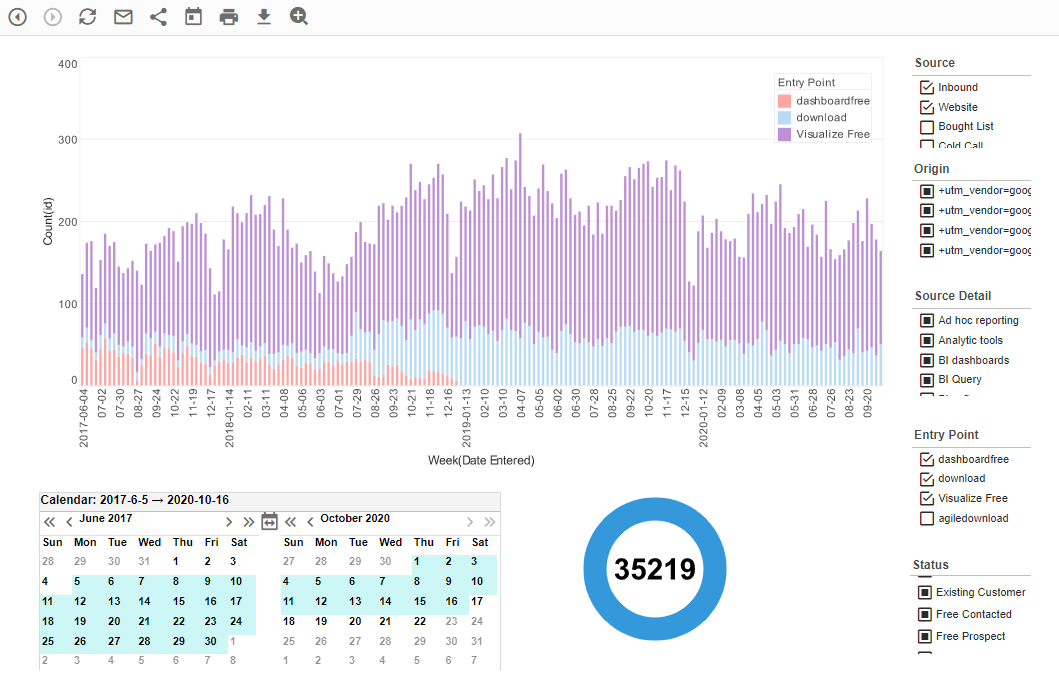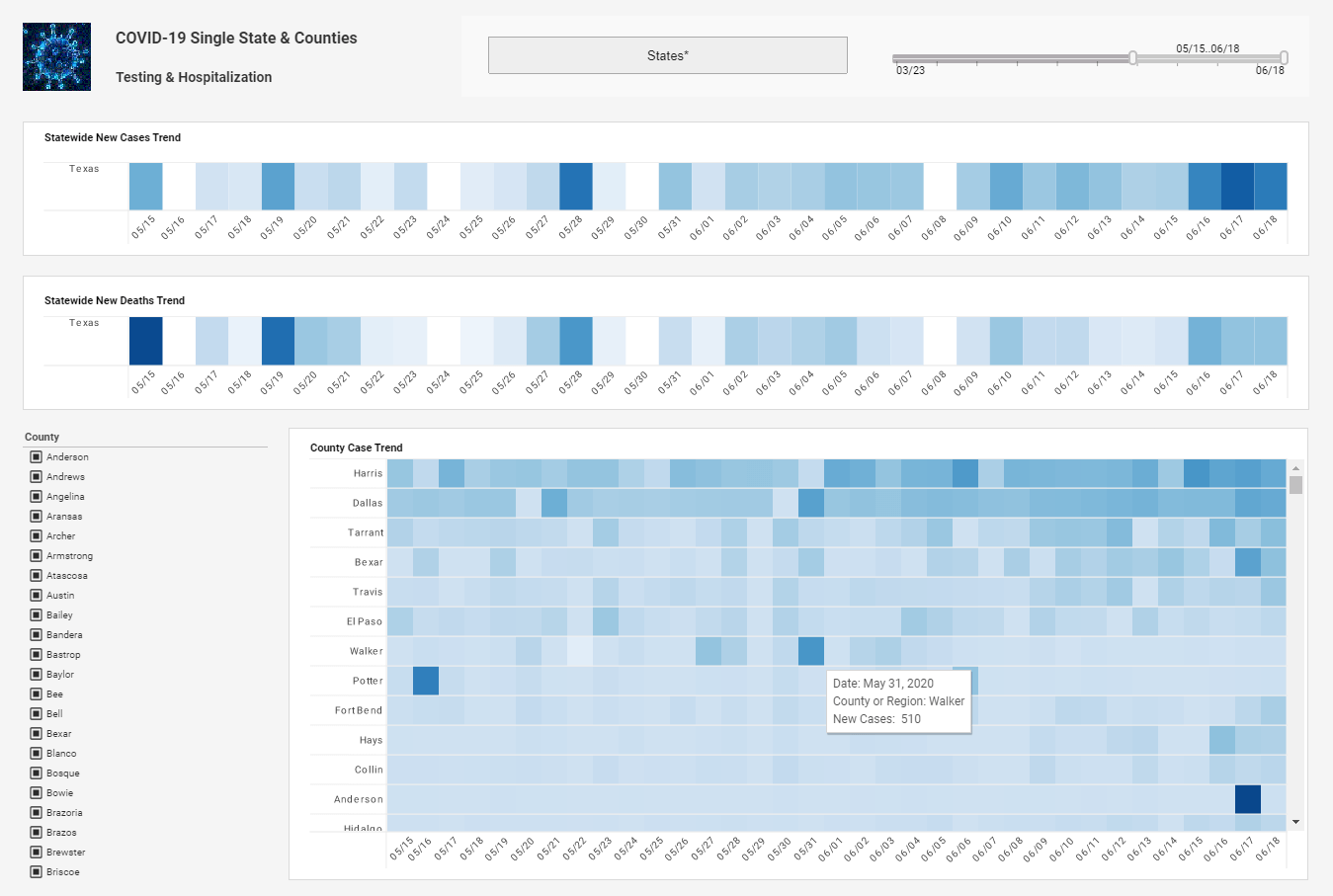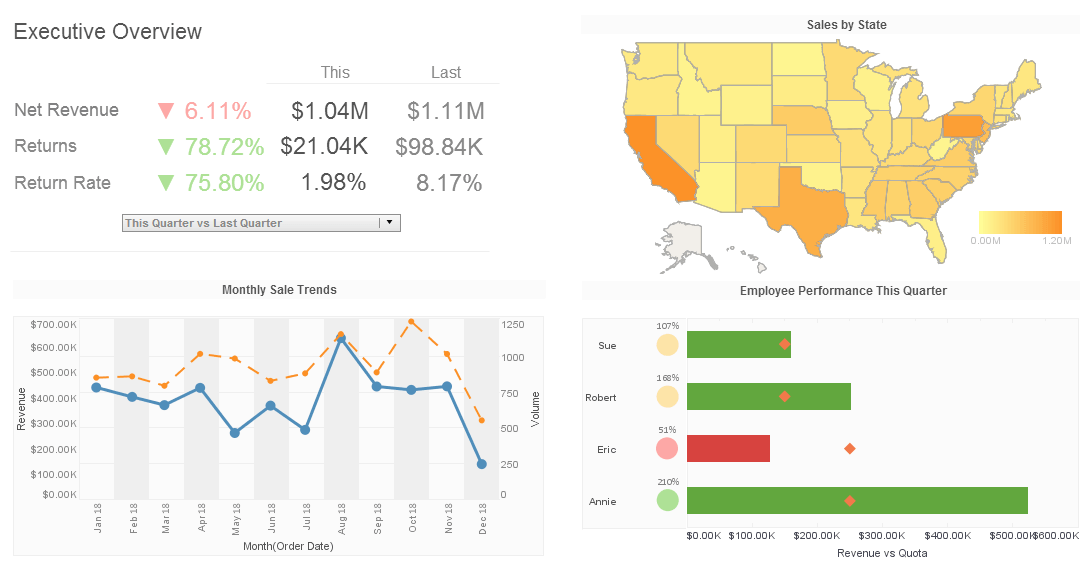Evaluate InetSoft's Software for Database Reports
Do you need to generate pixel-perfect paginated reports for scheduled distribution or self-service drill-down usage via a Web portal?
Do you want to report information in dashboards or scorecards, or want to offer point-and-click visual analyis?
InetSoft's StyleBI is an all-inclusive business intelligence application with powerful data mashup capabilities for combining disparate data sources of almost any type and enterprise levels of data security.


About InetSoft
Since 1996 InetSoft has been a pioneer in delivering easy, agile, and robust business intelligence software that make it possible for organizations and solution providers of all sizes to deploy or embed full-featured business intelligence solutions. InetSoft solutions have been deployed at over 5,000 organizations worldwide, including 25% of Fortune 500 companies, spanning all types of industries. Butler Analytics ranked InetSoft #1 BI supplier in 2015.



Customer Testimonials
“What I liked the most was the drag-and-drop feature for putting together a data query…with other solutions you have no choice but to sit and write code…but with StyleBI, it doesn’t take two to three hours to design reports – you only need ten to fifteen minutes. The more I get into it, the more capabilities I discover that allow me to organize data in ways that make the most sense to me, and excitingly, our users will be able to benefit from these same features. Additionally, Style Intelligence offers truly superior dashboard graphics. Thus, we’ll be able to provide our customers with the ability to create highly polished, professional reports.” - Tadd Meyers, Business Intelligence Manager at NCN
"Our solution implementing InetSoft's software has been in production for some time now, and we have been very pleased with its reliability. Another benefit we have found in having selected InetSoft is the company's responsiveness to our needs, something that can be lacking among other business intelligence software vendors." - Stewart Morse, Manager of Online Communication Systems at IBRC.
"We selected InetSoft's Style Report Enterprise for its powerful and flexible application programming interface and for the light weight of the Web-based information access and presentation application. We saved months of development time associated with initial internal development and were able to launch applications faster than if the reporting solution were developed in-house." - Dhruv Gupta, Vice President of Product Management at AmberPoint
 |
Read how InetSoft was rated as a top BI vendor in G2 Crowd's user survey-based index. |
What Do Laboratory Analysts Put in Database Reports?
Laboratory analysts play a crucial role in generating and managing data for scientific research and experiments. The contents of a database report created by a laboratory analyst typically include:
-
Experiment Details:
- Title of the experiment.
- Date(s) when the experiment was conducted.
- Name(s) of the experimenters or analysts involved.
-
Objective and Hypothesis:
- The specific goal or purpose of the experiment.
- Any hypotheses or expectations that were tested.
-
Experimental Design:
- Description of the experimental setup, including equipment used, reagents, and materials.
- Details about control groups, replicates, and any randomization procedures.
-
Methods and Procedures:
- Step-by-step instructions on how the experiment was conducted.
- Specific protocols followed, including any modifications made.
-
Data Collection:
- Raw data collected during the experiment. This may include measurements, observations, or any other relevant information.
- Timestamps for data points, if applicable.
-
Data Processing and Analysis:
- Details on any data cleaning, normalization, or transformation procedures applied.
- Statistical methods used for data analysis.
- Results of the data analysis, including any graphs, charts, or statistical values.
-
Results and Findings:
- A summary of the key findings from the experiment.
- Any trends, patterns, or significant observations.
- Comparative analysis with previous experiments or literature, if relevant.
-
Discussion and Interpretation:
- Interpretation of the results in the context of the experiment's objectives and hypotheses.
- Any unexpected outcomes and potential sources of error.
- Suggestions for further experiments or areas of research.
-
Conclusion:
- A concise summary of the main findings and their implications.
- Recommendations or conclusions drawn from the results.
-
References:
- Citations of any literature, protocols, or resources used during the experiment.
-
Appendices or Supplementary Information (if applicable):
- Any additional data, charts, graphs, or images that support the findings.
- Any supplementary information that provides context or clarity.
-
Quality Control and Assurance:
- Information about any quality control measures taken during the experiment.
- Details on calibration, validation, and reliability checks.
What Do Pharmaceutical Research Managers Put in Database Reports?
Pharmaceutical research managers oversee the development and execution of research projects within the pharmaceutical industry. They are responsible for ensuring that database reports contain comprehensive and relevant information. Here's what pharmaceutical research managers typically include in database reports:
-
Project Overview:
- Title and code of the project.
- Names of the researchers, analysts, and team members involved.
- Brief description of the project's goals and objectives.
-
Timeline and Milestones:
- Start and end dates of the project.
- Milestones achieved at various stages of the research.
-
Budget and Resource Allocation:
- Details of the budget allocated for the project.
- Breakdown of expenses, including personnel, equipment, supplies, and external services.
-
Regulatory Compliance and Ethical Considerations:
- Documentation of compliance with regulatory agencies' guidelines and requirements.
- Ethical considerations and approvals obtained from relevant review boards.
-
Study Design and Methodology:
- Detailed description of the study design, including experimental protocols, sample size, and control groups.
- Information about randomization, blinding, and any specific methodologies used.
-
Data Collection and Management:
- Overview of the data collection process, including types of data collected and sources.
- Details about data storage, security measures, and backup procedures.
-
Clinical Trial Information (if applicable):
- For clinical trials, additional information on patient recruitment, eligibility criteria, and informed consent procedures.
-
Data Analysis and Interpretation:
- Summary of data analysis methods and statistical techniques employed.
- Presentation of key findings, including any significant results or trends observed.
-
Safety and Adverse Event Reporting (if applicable):
- Documentation of any adverse events or safety concerns encountered during the research.
- Reporting procedures and actions taken to address safety issues.
-
Discussion and Conclusions:
- Interpretation of the results in the context of the project's objectives.
- Discussion of any unexpected findings, limitations, and potential implications.
-
Recommendations and Next Steps:
- Suggestions for future research directions based on the findings.
- Recommendations for potential modifications to the research approach.
-
Intellectual Property and Patents:
- Information regarding any intellectual property considerations, patents filed, or proprietary technologies developed during the project.
-
References and Citations:
- Citations of relevant literature, previous studies, and resources used in the research.
-
Appendices and Supplementary Information:
- Additional data, charts, graphs, or supplementary materials that support the findings.
 |
View live interactive examples in InetSoft's dashboard and visualization gallery. |
More Resources for Learning About Software for Database Reports
Alternative Firebird Reporting Tool - Looking for a good solution for Firebird dashboard reporting? InetSoft's pioneering BI application produces great-looking web-based dashboards with an easy-to-use drag-and-drop designer. Report targets triggers allow users to schedule metric alerts at needed intervals. InetSoft's visually driven reporting software empowers executives with the tools to extract and pair information when needed. View the information below to learn more about the StyleBI solution...
Analyzing Physician Drug Adoption Rates - Beyond the value of analyzing physician drug adoption rates, you can think about the kind of the affiliation structures that we've talked a little bit about that really helped to inform what your drug launch strategies should be based on, and how loosely or tightly aligned a doctor may be within our particular system. You also have the contact information for physicians whether that'd be the emails that we have on hand, the addresses where they're practicing for their...
Artificial Intelligence in Early Disease Detection - Accurate and prompt diagnosis, a critical element in healthcare can fail due to human capacity and cognitive limitations, to the detriment of patients. Poorly collected or kept medical histories affect the accuracy of diagnosis by doctors relying entirely on such records. Laboratory mix-ups and large caseloads overwhelm medical staff at times and lead to fatal human errors that can maim or cost human life in the worst-case scenario...
Claims Intelligence in Healthcare - Hi everyone, thank you for joining today's webinar. This session is about using claims intelligence in healthcare. By healthcare I mean life sciences, pharmaceutical companies, medical device companies, or biotechnology firms. And there are four customer segments one of which is healthcare providers. That might be hospitals and health systems or even some of those smaller more independent provider practices...
Creating Stored Procedures using InetSoft's BI Software - Stored procedures are compiled and stored in a database. There are a few major differences between a stored procedure and a SQL query: A stored procedure is invoked as a function call instead of a SQL query. Stored procedures can have parameters for both passing values into the procedure and returning values from the call. Results can be returned as a result set, or as an OUT parameter cursor...
 |
Read how InetSoft saves money and resources with deployment flexibility. |
Data Modeling Using the InetSoft BI Application - StyleBI provides a built-in module, called the Data Modeler, for connecting to data sources, designing queries, and defining semantic layers (logical models). Traditional query builders support only relational databases, but the Data Modeler supports multiple data source types, including XML, JDBC, EJB, text, and dozens more...
Examples of Database Dashboards - Dashboards offer companies various ways of representing their data. From sales projections, to employee statistics, and even inventory stock, database dashboards are able to easily represent all of the numerical data that your company can hold, into a visually appealing dashboard...
Evaluate InetSoft's Report Builder Software for Access - Looking for good report builder software for MS access? InetSoft's pioneering dashboard reporting application produces great-looking web-based reports that can be presented anywhere. But what if there was an easy-to-use report writer application that was both user-friendly and created professional, pixel-perfect reports every time...
 |
Learn about the top 10 features of embedded business intelligence. |
Fundamentals of Database Fields - In this post, we have gained an understanding of the fundamentals of Database Fields as well as the various kinds of field data that can be entered into a database. Those who are just starting out in their study of DBMS can profit greatly from the material presented here...
Information About Report Writer Software - Looking for report writer software? InetSoft offers Web-based reporting software that includes an easy drag and drop designer and powerful production reporting features. Free evaluation download. View a demo. Read customer reviews. The Scheduler must be running in order to use scorecards. 1. Create a data asset in the data worksheet, which retrieves the data to be monitored. 2. Create a metric: Specify one of the numeric fields in the asset as the metric. 3. Assign a detail report for the metric. 4. Create a target based on this metric...
Mashup Airtable CRM With Other Data - InetSoft's data mashup technology is the foremost tool for both designers and end users who want to bring together disparate data from multiple sources. Moreover, its built-in machine learning engine enables the mashup of machine generated intelligence with human intelligence, bringing data mashup to a new level...
Maximizing Drug Launches with Analytics - The second use case that we're going to explore is really focused around drug launches and being able to maximize what that launch experience looks like. The key question that we're going to go ahead and shine a light on is how a pharmaceutical company might really be able to understand some of the early adoption related to their drug in the effort of being able to maximize their sales and being able to maximize their marketing launch as well...
Option for MySQL Business Intelligence Dashboard Reporting - MySQL is the most widely used open source relational database management system on the planet. As such, you're probably looking for a BI tool that is usable with your existing MySQL database. InetSoft's BI product, StyleBI, provides MySQL tools for easy to use dashboard design, as well as enterprise-grade platforms for delivering interactive dashboards and reports to all users regardless of device...
 |
View the gallery of examples of dashboards and visualizations. |
Report Repository Functionality - InetSoft's reporting software provides users with a report repository that allows users to modify their data in a simple ordered and logical manner. View the information below to learn more about the StyleBI solution. The nodes under the 'Repository' node facilitate the configuration of the following properties...
Sixth Phase of Data Analytics: Act - Once you have performed the analysis, you must perform some actions with it to resolve the problem you defined in the first step. You can recommend the organizations to perform some actions and give them advices on decisions to be made. The company will now be able to perform data-driven decisions which are where data analysis comes to the rescue...
Solution for Relational Databases - In contrast to other business intelligence applications that provide only reporting, or only dashboards, or require an intermediate data access layer, StyleBI is complete. It includes analytics software and sophisticated reporting capabilities plus direct access to almost any data source...
Using InetSoft's Database Management Software - Take your data warehousing capabilities to the next level with InetSoft's BI Solution. StyleBI enhances database management by employing a powerful data mashup engine, providing a convenient web-based platform, and offering efficient tools for creating compelling dashboards and reports, as well as database management tools such as database writeback...

